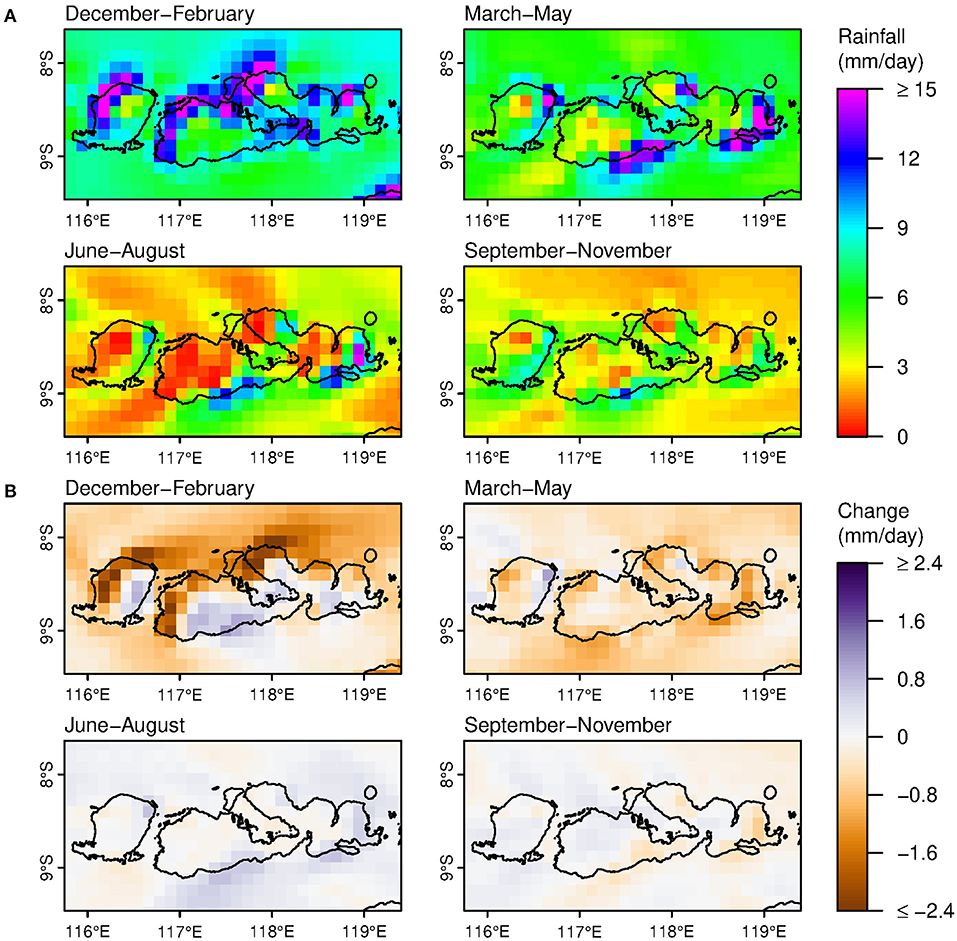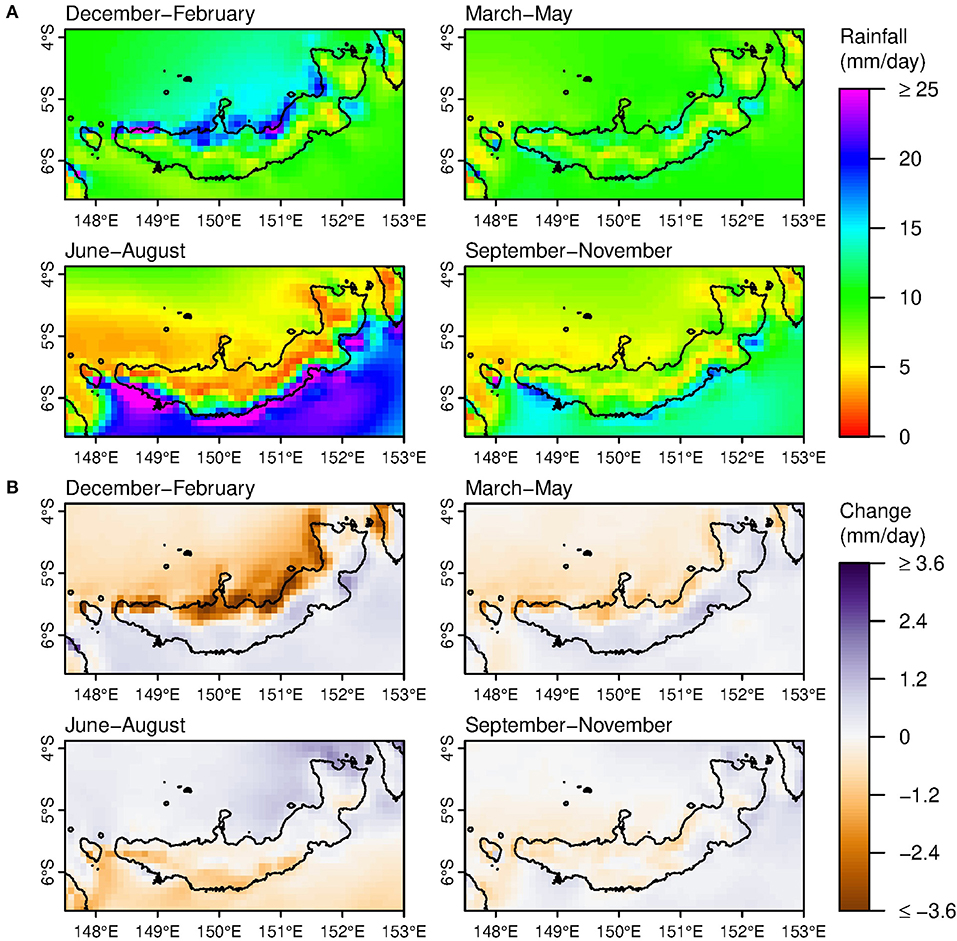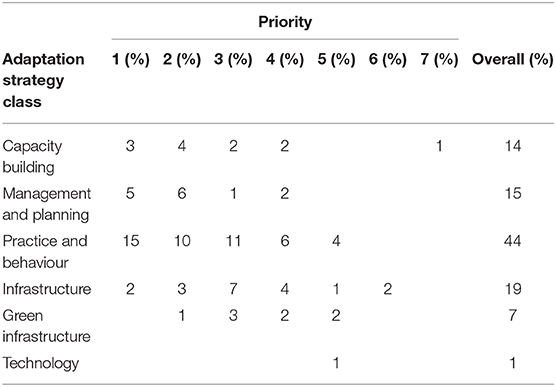How Feasible Is the Scaling-Out of Livelihood and Food System Adaptation in Asia-Pacific Islands?
- 1CSIRO Land and Water, EcoSciences Precinct, Brisbane, QLD, Australia
- 2CSIRO Oceans and Atmosphere, Brisbane, QLD, Australia
- 3CSIRO Land and Water, Black Mountain, Canberra, ACT, Australia
- 4CSIRO Land and Water, Australian Tropical Science Precinct, Aitkenvale, QLD, Australia
- 5CSIRO Oceans and Atmosphere, Aspendale, VIC, Australia
- 6The Nature Conservancy, Pacific Division, Brisbane, QLD, Australia
- 7Faculty of Agriculture, University of Mataram, Mataram, Indonesia
- 8Sekolah Tinggi Pariwisata, Mataram, Indonesia
- 9Faculty of Animal Sciences, University of Mataram, Mataram, Indonesia
- 10The Nature Conservancy, Papua New Guinea Field Office, Port Moresby, Papua New Guinea
- 11Forestry Division, West New Britain Provincial Administration, Kimbe, Papua New Guinea
- 12Griffin NRM, London Circuit, Canberra, ACT, Australia
The sustainable development and food security of islands in the Asia-Pacific region is severely compromised by climate change, sea level rise and compounding socio-economic issues. To achieve a step-change in food production and climate adaptation, livelihoods must rapidly transform. Food security programs continue to apply the “pipeline” model of scaling-out technological innovations, but do not account for the social-ecological complexity of islands. We tested the feasibility of scaling-out adaptation strategies in two provinces in the region: Nusa Tenggara Barat in Indonesia, and West New Britain in Papua New Guinea. Guided by a sub-district typology of resource use, we trialled a participatory, systems-based livelihood adaptation pathways approach in sub-district case studies. The process aimed to mainstream social learning and future uncertainty into community development decision-making, yielding ‘no regrets' adaptation strategies to transform livelihoods. We tested two assumptions: first, that because the contexts of all villages were homogenous, strategies were sufficiently similar to enable scaling-out across the provinces; second, that the sub-district typologies would assist scaling-out within each type. The results showed that the first assumption was untenable: there was very little similarity amongst villages' strategies; only sustainable fisheries management was scalable amongst coastal villages. The second was marginally tenable, because there were strong similarities amongst villages in an off-shore island type. When pooled into classes of adaptation strategy, most related to practice and behaviour change, and addressed systemic social issues; very few were technological. Our results suggest that scaling-out livelihood and food system innovations is not feasible due to the complex social-ecological contexts within islands, caused by steep climate gradients, natural resource and cultural diversity. We discuss the limitations of a resource use typology that aimed to mitigate this complexity and guide scaling-out. Instead we argue that appropriate social learning approaches akin to livelihood adaptation pathways must be mainstreamed into existing community development decision cycles, thereby “scaling-up” and “scaling-deep” to tackle institutional, political and cultural barriers to transformation. We discuss the implications of our recommendations for government and donor support for food security programs in islands of the Asia-Pacific region, and future research priorities.
Introduction
To supply growing global demand, agricultural systems must produce 60% more food by 2050 relative to 2005–2007 levels (Food Agriculture Organisation of the United Nations, 2015). Much of this production shortfall must be met by smallholder farmers (Herrero et al., 2017), while adapting to the largely negative impacts of climate change and variability, using resources more efficiently, and reducing greenhouse gas emissions (Keating et al., 2014; Lipper et al., 2014; Steffen et al., 2015). Yet livelihoods based on smallholder agriculture and fisheries in developing countries and regions are amongst the most vulnerable to climate and other drivers of change, due to low adaptive capacity and persistent poverty (Carter and Barrett, 2006; Ensor, 2011; Porter et al., 2014). Recent evidence indicates that the necessary transformations in food production are not occurring amongst these smallholders (Thornton et al., 2018), and this may be reflected in rising levels of undernourishment in many regions (Food Agriculture Organisation of the United Nations, 2018).
For decades it has been assumed that to achieve rapid and widespread changes in production amongst smallholders, science-driven technologies must be “scaled-out,” defined as delivering more benefits to more people over wider geographical areas, more quickly, equitably and lastingly (Franzel et al., 2001). This paradigm has been referred to as the linear “pipeline” model of technology innovation and diffusion (Biggs, 2007). However, there are growing concerns that blanket recommendations lead to low adoption amongst smallholders, and hence there are no “silver bullets” that can generate transformations in climate adaptation and resource efficiency (Giller et al., 2009; Biermann et al., 2012; Descheemaeker et al., 2016).
Instead, alternative approaches to achieving necessary transformation have been suggested. It has been argued that food production is a component of complex, adaptive social-ecological systems (Walker et al., 2010; Reed et al., 2013; Foran et al., 2014), and therefore multiple technological and social interventions are required simultaneously at different scales to generate systemic change (Giller et al., 2009; Scherr et al., 2012; Food Agriculture Organisation of the United Nations, 2013; Steenwerth et al., 2014; Westermann et al., 2018). In parallel, there has been a shift from dependence on the pipeline model to an “actor innovation” model, which deliberately aims to change social and power dynamics, and institutions and governance that are shaped by these relationships (Biggs, 2007). Consequently approaches based on collaborative learning, which integrate stakeholders' knowledge to stimulate social innovation and action (Kristjanson et al., 2014; Ensor and Harvey, 2015), and hence induce practice change in policy and institutional mechanisms (Gillespie et al., 2015; Dinesh et al., 2018) are gaining in popularity, and sometimes referred to as “scaling-up.” Riddell and Moore (2015) go further and advocate that for durable change to occur in complex systems, “scaling-deep” is also required, which transforms values and cultural norms by tackling the root causes of problems. Nonetheless, even when taking a participatory, systems-based perspective that engenders scaling-up and scaling-deep, the question remains to what extent the solutions formulated by such nuanced approaches can be scaled-out to generate widespread impact.
Islands provide an extreme challenge for transforming livelihoods and food production. By nature they are surrounded by sea and often isolated, and therefore frequently remote from markets and political centres; transport and other logistical costs are high; and natural resources, infrastructure and livelihoods are particularly exposed to both climatic and other natural hazards (Pelling and Uitto, 2001; Tompkins and Adger, 2002; Bunce et al., 2009). Consequently, many islands are highly vulnerable to damage and loss from climate change and related sea level rise, and their sustainable development is severely compromised [Climate Development Knowledge Network, 2014; UN-OHRLLS (Office of the High Representative for the Least Developed Countries, Landlocked Developing Countries and Small Island Developing States), 2015]. This is especially the case for the tropical island archipelagos of the Asia-Pacific nations (Hoegh-Guldberg et al., 2009; Asian Development Bank, 2011; Foale et al., 2013; Butler et al., 2014a,b; Bell et al., 2016), where rising levels of undernourishment are of growing concern (Food Agriculture Organisation of the United Nations, 2018).
Consequently, the necessity for transformation amongst rural communities is paramount in islands of the Asia-Pacific region. Yet the pipeline model of technical innovation and diffusion remains implicit in pan-regional food security programs, such as the Pacific Adaptation to Climate Change Program (2018), and the Coral Triangle Initiative on Coral Reefs, Fisheries and Food Security (2018), while systems-based approaches to planning and implementing adaptation and transformation of livelihoods and food systems are not common practice (Butler et al., 2015).
In this paper we assess the feasibility of scaling-out adaptation strategies formulated through a systems-based approach which exemplified scaling-up and scaling-deep. The study focussed on two island provinces in the Asia-Pacific region: Nusa Tenggara Barat in Indonesia, and West New Britain in Papua New Guinea. We compare the provinces' social-ecological characteristics, and the resulting adaptation strategies developed by a participatory, multi-stakeholder planning process carried out in 2011–2014. Our results highlight the limitations to scaling-out in island social-ecological systems due to the heterogeneity of socio-cultural contexts, combined with steep climate gradients and diverse resource use. Instead, we argue for the need to catalyse transformation by scaling-up iterative social learning and capacity building into existing community development decision-making, and reconfiguration of donor funding mechanisms to support this process.
Methods
Study Areas
Nusa Tenggara Barat Province, Indonesia
Nusa Tenggara Barat Province (NTB) is located in the island archipelago of eastern Indonesia (Figure 1). The province consists of two principal islands, Lombok (4,725 km2) and Sumbawa (15,448 km2), plus many smaller inshore islands. Lombok and Sumbawa are characterised by the active volcanoes of Mount Rinjani (3,726 m asl) and Mount Tambora (2,850 m asl), respectively. NTB has a tropical climate with a monsoon season of December-April. It is affected by the El Nino Southern Oscillation, which has a return period of 2–8 years, generating a variable climate and regular droughts that impact rice and other crop production, and food security (Yasin et al., 2007; Kirono et al., 2016). The orographic effects of Mount Rinjani and Mount Tambora create steep climate gradients across the islands. These are likely to become more acute with climate change (McGregor et al., 2016), as suggested by downscaled climate simulations for rainfall (Figure 2). Coastal erosion and land loss are already evident as a result of sea level rise, exacerbated by intensifying monsoon storms (Gunawan et al., 2020).

Figure 1. The locations of Nusa Tenggara Barat (NTB) Province in Indonesia, and West New Britain (WNB) Province, Papua New Guinea (PNG).

Figure 2. Downscaled seasonal rainfall projections for Nusa Tenggara Barat in 2060 at 14 km resolution, showing (A) projected rainfall and (B) changes relative to 1990. Simulations are for the global SRES A2 emissions scenario (see McGregor et al., 2016 for details).
There are eight rural districts, consisting of 105 sub-districts (kecamatan) and 996 villages (desa). NTB is one of the poorest provinces in Indonesia. In 2014 the poverty rate was 17%, and the majority of poverty occurs in rural areas (Badan Pusat Statistik, 2015). NTB's Human Development Index (HDI) was 0.646 in 2009, equivalent to a medium human development level (United Nations Development Program, 2011). The total population was 4.5 million in 2010, with a growth rate of 1.2% per annum. Although annual growth rates will decrease to <1% per annum by 2050, projections suggest that the population may increase by 44% to 6.5 million in 2050. Approximately 70% of the population live on Lombok at a density of 671 people per km2, and 30% live on Sumbawa at a density of 86 people per km2 (Fachry et al., 2011). The predominant religion is Islam. There are three ethnic groups: Sasak in Lombok and Samawa and Mbojo in Sumbawa, plus immigrant Balinese, Javanese and Sundanese. Amongst the Sasak there is variation between orthodox Islam and more traditional values and beliefs (Fachry et al., 2011).
The combination of steep climate gradients, variations in soil types, culture, economic opportunities and human development results in a diversity of rural livelihood activities (Rochester et al., 2016; Skewes et al., 2016). Farming systems are typified by small land areas (usually <2 ha) that support an integrated mix of crops, forage and livestock, combined with other activities such as migrant labour (Lisson et al., 2010). The primary livelihood outcomes sought by farmers are fulfilling the family's basic food needs, financing children's schooling and saving for a pilgrimage to Mecca (Sjah et al., 2006).
Community development planning is carried out by the musrenbang process, which was established in 2004 to encourage decentralised and integrated top-down and bottom-up decision-making. The process involves annual multi-stakeholder consultations at the village, sub-district and district government levels (Purba, 2011).
West New Britain Province, PNG
West New Britain Province (WNB) forms two-thirds of the land area of the island of New Britain, which is located in the Bismarck Sea archipelago in northern PNG (Figure 1). WNB has an area of 20,455 km2, and is characterised by steep forested topography reaching 2,185 m asl. The island is highly volcanic, with 21 active volcanoes. It also has numerous smaller inhabited inshore and offshore islands. Similarly to NTB, WNB has a seasonal cycle of rainfall, with a peak in December-February, and the province is occasionally affected by the El Nino Southern Oscillation, which can cause drought events at approximately 30 year intervals (Bourke, 2005). As for NTB, there are steep climate gradients across WNB caused by the mountainous topography. Downscaled climate projections suggest that these gradients will intensify, with rainfall declines along the north coast, and increases along the south coast (Figure 3). As in other regions of PNG (Butler et al., 2014a; Leutz and Havea, 2017), sea level rise and coastal erosion is already evident.

Figure 3. Downscaled seasonal rainfall projection changes for New Britain in 2055 at 8 km resolution, showing (A) projected rainfall and (B) changes relative to 1990. Simulations are for the global SRES A2 emissions scenario (see McGregor et al., 2016 for methodological details).
WNB has two districts, consisting of 10 rural Local Level Governments (LLGs) and 111 village “wards.” In 2011 the total population in WNB was 242,676, which had increased by 2.5% per annum since 2000 (National Statistical Office, 2012), and could double to 500,000 by 2040 (Butler et al., 2012). The population is concentrated in the flatter northern coastal areas. In this region high population densities are partly driven by labour immigration attracted by the oil palm industry (Koczberski et al., 2006). The offshore islands of Bali-Witu have the highest population densities of 188 people per km2. No data on poverty are available, but in 2007 WNB's HDI was 0.522 (McGillivray, 2012), ranking it below NTB and equivalent to the lowest levels of medium human development (United Nations Development Program, 2011). The predominant religion is Roman Catholic and Anglican Christianity. These beliefs are mixed with traditional animism held by seven major tribes speaking 25 languages (Koczberski et al., 2006).
Livelihoods are primarily based upon agriculture and coastal fisheries. The most common activity is growing food crops in gardens, involving 70% of households (National Research Institute, 2010). Oil palm, timber and copra are the primary commodities exported. Plantation oil palm production is focussed along the flat terrain along the northern coast, where livelihoods have shifted to a cash economy, but away from this area livelihoods are more subsistence-based (Koczberski et al., 2006; National Research Institute, 2010). Due to limited transport infrastructure and local cultural practices, resource use varies widely from the more accessible areas in the north to the remoter regions (National Research Institute, 2010).
In order to decentralise government, and to better engage communities in decision-making, the 1995 Organic Law on Provincial and Local Governments devolved planning to 5-yearly LLG Development Plans. These incorporate Ward Development Plans, which are formulated by elected ward councillors in consultation with their communities, supported by district administrators (Kalinoe, 2009).
Typologies of Sub-district Resource Use
Because livelihoods differ markedly over short distances in both provinces, typologies of rural sub-districts (i.e., kecamaten in NTB and LLGs in WNB) were generated based on communities' use and valuations of ecosystem goods and services (see Rochester et al., 2016). The sub-district types formed the units of analysis for participatory modelling of downscaled climate change and population growth impacts on ecosystem goods and services carried out during the planning process, which guided the design of adaptation strategies (see below; Skewes et al., 2016). It was also intended that the typologies could potentially inform the scaling-out of adaptation strategies amongst villages (i.e., desa in NTB and wards in WNB) within each sub-district type.
Based on available information (i.e., statistics, grey literature, expert opinion, local elicitation), lists of ecosystem goods and services were compiled for each sub-district, and semi-quantitatively scored by local key informants according to their relative importance for food security, income, health and culture (see Rochester et al., 2016; Skewes et al., 2016). Cluster analysis was then carried out for each province, yielding seven types in NTB, and four in WNB (Figure 4). The NTB typology captured 42% of the variation in the data, and the WNB typology captured 85%.

Figure 4. The resource use typologies for rural sub-districts in (A) NTB and (B) WNB, and case studies where adaptation planning was carried out.
Adaptation Planning Process
Between 2011 and 2014 a pilot planning process was conducted with the aim of mainstreaming climate compatible development into musrenbang in NTB, and Ward and LLG Development Plans in WNB. Due to accelerating climate change and its interactions with other drivers such as population growth, increasing economic volatility and modernisation, planning must take a systems approach to community development and poverty alleviation, while identifying and tackling the root causes of vulnerability, and building stakeholder's adaptive capacity (Butler et al., 2014b). Our methodology aimed to achieve this by integrating the anticipatory decision-making construct of adaptation pathways (Wise et al., 2014) with livelihood analysis and action research to create “livelihood adaptation pathways.” Our approach applied Participatory Systemic Inquiry and social learning to empower stakeholders to understand and then purposefully induce systemic change through pivotal social and technological interventions. The output of the process was “no regrets” strategies which yield benefits under any future conditions of change, and agreed decisions to implement them which are sequenced over time, thus accounting for future uncertainty (see Butler et al., 2015, 2017a for conceptual details). This approach followed the framing of food production as a component of complex, adaptive social-ecological systems, whereby interacting biophysical, social, cultural, political and technological factors drive food and livelihood outcomes (Walker et al., 2010; Foran et al., 2014).
Two-day workshops were carried out with 25–35 community leaders, civil society and government officers in seven case study sub-districts (Figure 4), which mirrored the consultative decision-making undertaken by musrenbang and Ward and LLG Development Plan processes. Workshop sessions moved through six learning steps: (1) assessment of current drivers of change for livelihoods; (2) agreement of a transformational vision for livelihoods in the sub-district; (3) construction of potential future scenarios for livelihoods considering the uncertainty amongst the drivers of change and potential shocks; (4) analysis of potential impacts of change (including climate hazards) on the sub-district's natural resource base using participatory modelling that integrated downscaled climate and population projections (see Skewes et al., 2016); (5) assessment of the current adaptive capacity of each village; and (6) formulation of no regrets strategies for villages which would establish pathways toward the vision. In this way strategies were tailored to locally-specific current and potential climate change and population pressures, and adaptive capacity. Participants prioritised strategies, ranging from those that were most important and/or had the least risk of maladaptation (high), to those that were less critical and/or had some risk of maladaptation (low) (see Butler et al., 2016c, 2018 for process details).
The process was undertaken in five case study sub-districts in NTB, and two in WNB (Figure 4). In NTB, two pairs of case studies occurred in the same types: Jerowaru and Sape (Type 1), and Janapria and Terara (Type 5). Within the sub-districts participants chose to focus either on all villages, or a sub-set of villages. Overall, 31 villages were assessed, with 21 in NTB and 10 in WNB (Table 1).

Table 1. Characteristics of the case study sub-districts in NTB and WNB, and villages assessed within them.
At the beginning of each workshop written free prior and informed consent was requested and received from all participants. In case their understanding of written English and/or Bahasa Indonesia was limited, prior and informed verbal consent was also sought and received from everyone. CSIRO's Human Research Ethics Committee endorsed this approach (approvals 041/10 for Indonesia and 037/12 for PNG).
Data Analysis
We made two primary assumptions about the feasibility of scaling-out adaptation strategies. First, we assumed that all villages in the NTB and WNB case study sub-districts formulated the same strategies, and prioritised them similarly, and therefore they were likely to be scalable across both provinces. Beneath this assumption lay the logic that despite their social and cultural differences, both NTB and WNB were tropical islands of similar land areas which experienced equivalent seasonal climates, climate change, extreme events (e.g., droughts caused by the El Nino Southern Oscillation), and coastal impacts from sea level rise.
Second, we assumed that if the first assumption was untenable, strategies could instead be scaled out amongst villages within sub-district types because their resource use regimes (including agricultural and fisheries production) were the same, and pressures from climate change and population growth on the resource base would also be geographically specific.
To investigate the validity of these assumptions, we first constructed a village-by-strategy matrix, wherein the score for each strategy was the reciprocal of the strategy's priority. To compare all villages' strategies, and those within sub-district types, we then calculated the Steinhaus Similarity Index (SSI), with a maximum value of 1 (Legendre and Legendre, 2012). To further analyse the characteristics of strategies within sub-district types, we calculated an index of value (IndVal) and its components, specificity and fidelity (Dufrene and Legendre, 1997). Specificity indicates whether a strategy is concentrated in a particular type, fidelity is the frequency of the strategy in each type, and IndVal combines the two.
Because the strategies were so diverse, we also pooled them into the 10 adaptation strategy classes defined by Biagini et al. (2014): capacity building, management and planning, practice and behaviour, policy, information, physical infrastructure, warning or observing system, green infrastructure, financing, and technology. Following this pooling we repeated the analyses described above for both assumptions.
Results
Adaptation Strategies
Among the 31 villages assessed, 56 adaptation strategies were formulated, with a total occurrence of 124 (Figure 5), and an average of four strategies per village (range 2–7). Highest priority strategies among villages included social interventions (e.g., empowerment of women, population control, improve education and skills), natural resource management (e.g., sustainable fisheries management, landuse planning), training and capacity building (e.g., training for livestock farmers), income enhancement (e.g., diversify income through aquaculture), and infrastructure (e.g., improve road and irrigation infrastructure). Only five (16%) of the highest priority strategies related directly to food production: intensify rice production, intensify agricultural production, improve goat nutrition, cashew post-harvest processing, and improve agricultural produce quality, but some others aimed to build the capacity of farmers through training. Only one (3%) directly targeted climate impacts, the building of coastal protection from sea level rise in Malala village, Hoskins sub-district, WNB (Figure 5), where severe coastal erosion was occurring.

Figure 5. The 56 adaptation strategies designed for each village, and their priority. Villages are grouped by sub-district type.
Similarity of Strategies Amongst Villages
The similarity between all villages was very low (Figure 6), with an average SSI of 0.07. When the provinces were compared, similarities were higher within WNB (average 0.25) than within NTB (average 0.05). The cluster of highest similarities were within Bali-Witu sub-district, a group of small off-shore islands (Figure 4B). There was some overlap between Bali-Witu villages and two villages in Hoskins sub-district, WNB, and strong similarities amongst two villages in Hoskins (Kalu and Voloka). There was also a cluster of high similarities between three villages (Selagik, Lando, and Pandan Dure) in Terara, an inland sub-district in NTB (Figure 6).

Figure 6. Similarity matrix between villages' adaptation strategies. Similarity is represented by the Steinhaus Similarity Index.
Sustainable fisheries management was the most commonly selected of all strategies across NTB and WNB, occurring in 35% of villages. This was followed by improvements to freshwater supplies and sanitation, and road and irrigation infrastructure (19% each).
Similarity of Strategies Within Sub-district Types
The similarity between villages within each sub-district type was double that of all villages (average SSI 0.14), but still low. The type with the highest similarity was WNB Type 3 (Bali-Witu), with an average of 0.4 (Table 2). The SSIs between one pair of case study sub-districts in Type 5 of NTB, Janapria and Terara, were considerably different, (0.06 vs. 0.29), while in the other, Jerowaru and Sape in Type 1, the SSIs were more similar (0.11 vs. 0.08; Table 2).

Table 2. Steinhaus Similarity Index (SSI) of adaptation strategies for villages within the case study sub-districts in NTB and WNB.
The average maximum specificity was high (87%), indicating that strategies tended to be particular to a sub-district type. However, the average maximum value for fidelity was low (26%) due to the rarity of most strategies; 52% of strategies were selected by only one village each. Consequently the combined IndVal was generally low (Figure 7), with an average maximum value of 21%.

Figure 7. Values of strategies within sub-district types. Specificity indicates whether a strategy is concentrated in a particular type, fidelity is the frequency of the strategy in each type, and IndVal combines the two.
Pooled Adaptation Strategies
Pooling into Biagini et al.'s (2014) classes showed that strategies only occurred in six: capacity building, management and planning, practice and behaviour, physical infrastructure, green infrastructure and technology (Table 3). None fell within the classes of policy, information, warning or observing system, or financing, and only 1% was related to technology (introduce solar energy). Almost half of all strategies (44%) were related to practice and behaviour, followed by infrastructure (19%), management and planning (15%) and capacity building (14%). Amongst the top priority strategies, the highest proportion (15%) fell within the practice and behaviour class.

Table 3. The 56 adaptation strategies' occurrence (n = 124) among the 31 villages in NTB and WNB, pooled into Biagini et al.'s (2014) classes.
The similarity between all villages was higher than for the disaggregated strategies (average SSI 0.54 vs. 0.07), and when compared within each province similarities increased to similar levels in NTB (average 0.54 vs. 0.05) and WNB (average 0.58 vs. 0.25). The specificity and fidelity of pooled strategies were lower and higher, respectively, than for the disaggregated data due the generalisation effect, but the average maximum IndVal increased to only 28% (from 21%).
Discussion
In this study we applied a participatory, systems-based approach combined with a sub-district resource use typology to analyse rural livelihoods and food production, current and future climate and other pressures, in order to design “no regrets” strategies which would potentially generate systemic change in the case study sub-districts. The process was replicated identically in all case study sub-districts. Fifty-six strategies were formulated for 31 villages in NTB and WNB. We tested two assumptions about the feasibility of scaling these out across the islands.
First, we assumed that our adaptation planning process would yield similar adaptation strategies for the villages concerned. Clearly this assumption was not tenable. A diverse range of strategies were formulated, and the highest priority strategies included social interventions, natural resource management, training and capacity building, diversification of income and construction of infrastructure. Only 16% of these related directly to food production (although some training was aimed at farmers), and only one directly targeted climate impacts. The similarity between the villages was very low, although there appeared to be greater similarity in WNB than in NTB. This may have been a function of the smaller number of villages assessed in WNB (10) than in NTB (21), and the fact that both sub-district case studies in WNB were coastal, while two of the five in NTB were in-land. There were some clusters of higher similarities amongst villages in both WNB and NTB, but these were the exception. The only strategies which were relatively common, and therefore could potentially be scaled-out to some degree were sustainable fisheries management, and improved freshwater supplies and sanitation, road and irrigation infrastructure. However, fisheries-related interventions would only be relevant to coastal villages where livelihoods involved fishing, fish-processing or aquaculture.
The second assumption was that in the expectation that province-wide scaling-out was not possible, the sub-district resource use typologies in NTB and WNB would provide a basis for scaling out amongst villages within them. This was underpinned by a further implicit assumption that villages in each type would have similar agricultural or other natural resource use regimes, and pressures from climate change and population growth on the resources would be locally-specific. This assumption was partially tenable. The similarities amongst the sub-district types were double those of all villages combined, but still low, and only Bali-Witu sub-district in WNB had an SSI approaching 0.5. It may be relevant that this sub-district was a group of off-shore islands, and consequently livelihoods, climate change and population growth impacts may have been more uniform in this discrete location. Importantly, there was little similarity between the two pairs of sub-districts in the same types in NTB, suggesting that scaling-out across sub-districts within the same type may not always be appropriate. This finding was reinforced by the low IndVal results, which indicated that while most strategies were unique to one type, they were usually selected by only one village each, and were therefore not necessarily suitable for all villages in a type.
These results suggest that, perhaps with the exception of smaller off-shore islands, scaling-out strategies produced by a systems-based planning process is not feasible, even amongst villages within sub-district types. The primary explanation is that by analysing livelihoods holistically, and therefore considering multiple drivers of change, including both climate change and human population pressures, plus the diversity of socio-cultural issues, highly variable responses are generated at the village level. The socio-cultural heterogeneity amongst rural communities in NTB and WNB was marked, with an overall Islamic culture in NTB overlaying three ethnic groups plus other immigrant entities, and in WNB a Christian culture overlaying animism and 25 language groups, resulting in likely variations in values assigned to ecosystem services, livelihood priorities and decision-making processes. In addition, population densities varied across the islands, from 86 people per km2 in Sumbawa to 671 people per km2 in Lombok, and up to 188 people per km2 in WNB's Bali-Witu islands. For small islands in PNG, such as Bali-Witu, it has been estimated that at current levels of development, there is a threshold population density of 120 people per km2, above which food and water security declines (Butler et al., 2014a). Likewise, population growth rates varied considerably between the provinces, with 1.2% per annum in NTB, and the higher rate of 2.5% per annum in WNB may lead to a doubling of the population by 2040. Furthermore, this variability in local contexts was exacerbated by the range of participants attending the workshops, who in NTB had differing “knowledge cultures” which influenced their perceptions and priorities (Bohensky et al., 2016).
Overlaying the socio-cultural diversity are the steep climate gradients typical of the islands, illustrated by the down-scaled climate simulations, plus the range of natural resources available for utilisation. During the workshops the climate projections were integrated with population projections to identify the ecosystem goods and services most likely to be impacted at the sub-district and village scale (Skewes et al., 2016). Consequently, even within sub-district types, participants could identify markedly different responses to mitigate impacts from one village to the next. These results therefore emphasise the utility of downscaled climate simulations for informing adaptation planning across island archipelagos in the Asia-Pacific region. However, there may be some scales and topographies for which climate gradients are less tangible, for example small off-shore islands, and particularly those that are low-lying (e.g., coral atolls) and therefore do not generate orographic effects (McGregor et al., 2016), such as Bali-Witu in WNB.
To ameliorate the diversity of strategies and the resulting impediment to scaling-out, we pooled the strategies using Biagini et al.'s (2014) classes. The result was higher levels of similarity across all villages, and within sub-district types, but wide variation still remained, further undermining the tenability our assumptions. Furthermore, the generalisation of the strategies would obscure their intentional specificity to local contexts. It is notable from this analysis, however, that strategies predominately fell into the practice and behaviour class, as did many priority strategies, and there was only one technological strategy. Also, none of the strategies were classified as policy, information, warning or observing system, or financing. This reveals participants' focus on social and institutional issues within their systems, and the need to address these rather than introduce technological innovations, either for agriculture or other livelihood activities. However, whether the practice and behaviour interventions will generate the necessary systemic change is questionable: in NTB's Janapria case study the majority of strategies addressed the symptoms of vulnerability, rather than their root causes (Butler et al., 2016a). For change to occur at the scale and degree required to transform livelihoods and food systems, identifying and tackling the underlying institutional and political drivers of vulnerability is paramount (Lemos et al., 2007; Pelling, 2011; Rodima-Taylor et al., 2012).
To address the effects of social-ecological heterogeneity, we developed resource use typologies in NTB and WNB. In sub-Saharan Africa, failure of the pipeline model of technological innovation and diffusion has been attributed to the diversity of agro-ecological, cultural, economic and institutional factors, plus the geographically-specific manifestations of climate change (Descheemaeker et al., 2016). Tools to overcome these constraints have included the definition of local social-ecological “niches” (Ojiem et al., 2006; Franke et al., 2014), and participatory farming systems analysis (Descheemaeker et al., 2016). Our typologies aimed to address this challenge by assessing ecosystem goods and services utilised by communities at the sub-district scale; however, unlike Ojiem et al.'s (2006) niches we could not account for the intricate socio-cultural dimensions of livelihoods overlaying the resource base due to a lack of suitable information (Rochester et al., 2016). Another shortcoming was that due to the diversity of the resource use patterns in NTB the typology captured only 42% of the variation in that province's data, compared to 85% in WNB, which potentially undermined the typology's predictive power and utility for scaling-out.
It is arguable that few technological interventions were identified, particularly for food production, because participants were not aware of available options and innovations. Although the workshops included sources of technical expertise (e.g., local government agriculture and fisheries agencies, civil society organisations), and their knowledge (Butler et al., 2015; Bohensky et al., 2016), it is possible that they were not aware of contemporary techniques and solutions, either. However, prior workshops were held at the provincial level amongst higher-scale stakeholders (e.g., national government, universities) which assessed the sub-district types using the same livelihood adaptation pathways process. With less awareness of local sub-district and village contexts, their strategies tended to emphasise scientific and technically-based strategies (Butler et al., 2016a), some of which were subsequently trialled within case study sub-districts in partnership with local farmers (Butler et al., 2016b; Liu et al., 2016). The strategies from the provincial scale and sub-district case studies were also integrated in a third stage of workshops (Butler et al., 2015), resulting in the inclusion of some technological interventions, but the emphasis on social and behavioural interventions identified by the sub-district and village level participants remained strong (Wise et al., 2016).
It is acknowledged that adaptation and transformation of smallholder's livelihoods and food production requires an integrated approach based on collaborative learning which can integrate stakeholders' knowledge to stimulate social innovation and action (Kristjanson et al., 2014; Ensor and Harvey, 2015), and hence induce practice change in policy and institutional mechanisms (Gillespie et al., 2015; Dinesh et al., 2018), or scaling-up. Riddell and Moore (2015) propose that scaling-deep is also required, whereby values, cultural practices and the quality of relationships are transformed. Thus, a combination of tactics are required that can simultaneously achieve scaling-out, scaling-up and scaling-deep, including analysing root causes of problems, and building networks and partnerships (Riddell and Moore, 2015). In the case of livelihood and food systems in island archipelagos of the Asia-Pacific region, we suggest that NTB and WNB are representative of the heterogeneity caused by diverse socio-cultural, climate and natural resource profiles that are characteristic of these locations (Hoegh-Guldberg et al., 2009; Butler et al., 2014a; Bell et al., 2016). Consequently, even when adopting the necessary systems approach to address localised livelihood challenges and to identify systemic solutions, the feasibility of scaling-out resulting strategies is limited, perhaps with the exception of smaller off-shore islands. In these situations, we suggest that scaling-up and scaling-deep will be of even greater importance than in other contexts.
To this end, it is the mainstreaming of systems-based social learning processes, such as livelihood adaptation pathways, into existing development decision-making cycles that is most likely to lead to the requisite transformation to climate compatible and enhanced food production. This has two implications for government and donor support for initiatives aiming to establish scaling-up and scaling-deep. First, prerequisite capacity building will have to be delivered to all district and sub-district stakeholders within a province, and on a recurring basis for elected officials and other temporary community representatives. Second, our evaluation of the NTB process indicated that while capacity for transformation can be primed amongst communities and stakeholders, realising necessary governance reconfiguration requires consistent support for change agents, particularly in conditions of institutional flux caused by decentralisation, and hence long-term investments (Butler et al., 2016c).
Some important further research is also necessary to inform the design of scaling-out and scaling-deep initiatives. First, the length of time required to instigate institutional change within local planning processes is not clear, and may vary between contexts. In NTB we estimated that at least 5 years of ongoing engagement is necessary (Butler et al., 2016c), while in countries with lower capacity such as PNG this may require 10 years or more (Stone-Jovicich et al., 2015). In addition, knowledge integration and power dynamics in participatory decision-making are key determinants of institutional change, and require greater understanding and engagement by researchers (Tschakert et al., 2016; Butler et al., 2020). Tools and processes which can trigger double- and triple-loop learning, and thus the identification of transformational strategies are also imperative, but the social psychology necessary to design such tools and accurately attribute their impact is nascent (Butler et al., 2017b). Overall, if these research questions are to be answered, evaluation approaches must be employed which can track and record change from a complex systems perspective (Maru et al., 2018).
Data Availability Statement
All datasets generated for this study are included in the article/supplementary files.
Ethics Statement
This study was carried out in accordance with the recommendations of the Australian National Statement on Ethical Conduct in Human Research, CSIRO Human Research Ethics Committee with verbal consent from all subjects. All subjects gave informed consent in accordance with the Australian National Statement on Ethical Conduct in Human Research (2007). The protocol was approved by the CSIRO Human Research Ethics Committee.
Author Contributions
JB conceived, designed and led the study and wrote the paper. WR and TS carried out the statistical analyses. RW, EB, NP, WS, YY, TH, PH, IJ, YS, BM-L, DV, and KD co-designed, prepared, facilitated, and collated data from the workshops. JK and DK prepared downscaled climate projection data.
Funding
The authors acknowledge funding provided for this work by the Australian Government's Department of Foreign Affairs and Trade (DFAT), through the DFAT-CSIRO Research for Development Alliance (NTB) and the Coral Triangle Initiative on Coral Reefs, Fisheries and Food Security (WNB).
Conflict of Interest
The authors declare that the research was conducted in the absence of any commercial or financial relationships that could be construed as a potential conflict of interest.
Acknowledgments
The authors are also grateful to other members of the University of Mataram (NTB) and West New Britain Provincial Administration (WNB) who provided logistical support for the research, and the community leaders and members, government, civil society organisations and private sector representatives who participated in the sub-district planning workshops.
References
Asian Development Bank (2011). Food Security And Climate Change In The Pacific: Re-Thinking The Options. Manila : ADB Pacific Study Series. Available online at: https://www.adb.org/sites/default/files/publication/29078/climate-change-food-security.pdf
Badan Pusat Statistik (2015). Statistics of Nusa Tenggara Barat Province. Available online at: http://ntb.bps.go.id/linkTabelStatis/view/id/72.
Bell, J., Taylor, M., Amos, M., and Andrew, N. (2016). Climate change and Pacific Island food systems. Copenhagen; Denmark; Wageningen: CCAFS and CTA.
Biagini, B., Bierbaum, R., Stults, M., Dobardzic, S., and McNeeley, S. M. (2014). A typology of adaptation actions: a global look at climate adaptation actions financed through the global environment facility. Glob. Environ. Chang. 25, 97–108. doi: 10.1016/j.gloenvcha.2014.01.003
Biermann, F., Abbott, K., Andresen, S., Backstrand, K., Bernstein, S., Betsill, M. M., et al. (2012). Transforming governance and institutions for global sustainability: key insights from the earth system governance project. Curr. Opin. Environ. Sustain.4, 51–60. doi: 10.1016/j.cosust.2012.01.014
Biggs, S. (2007). Building on the positive: an actor innovation systems approach to finding and promoting pro poor natural resources institutional and technical innovations. Int. J. Agric. Resour. Gov. Ecol. 6, 144-−164. doi: 10.1504/IJARGE.2007.012701
Bohensky, E. L., Kirono, D., Butler, J. R. A., Rochester, W., Habibi, P., and Handayani, T. (2016). Climate knowledge cultures: stakeholder perspectives on change and adaptation in nusa Tenggara Barat, Indonesia. Clim. Risk Manag. 12, 17–31. doi: 10.1016/j.crm.2015.11.004
Bourke, R. M. (2005). How Papua New Guinea villagers survived the 1997 drought and frosts. Dev. Bull. 67, 27–29.
Bunce, M., Mee, L., Rodwell, L. D., and Gibb, R. (2009). Collapse and recovery in a remote small island - a tale of adaptive cycles or downward spirals? Reg. Environ. Chang. 19, 213–226. doi: 10.1016/j.gloenvcha.2008.11.005
Butler, J. R. A., Williams, L. J., Darbas, T., Jakimow, T, Maclean, K., and Grunbuhel, C. (2017a). “Integrating development studies and social-ecological systems thinking: towards livelihood adaptation pathways,” in Social Science and Sustainability, eds H. Schandl and I. Walker (Canberra, ACT: CSIRO Publishing), 51–73.
Butler, J. R. A., Bergseng, A.-M., Bohensky, E. L., Aitkenhead, M., Pedde, S., and Hamden, R. (2020). Adapting scenarios for climate adaptation: practitioners' perspectives on a popular planning method. Environ. Sci. Policy 104, 13–19. doi: 10.1016/j.envsci.2019.10.014
Butler, J. R. A., Bohensky, E. L., Darbas, T., Kirono, D. G. C., Wise, R. M., and Sutaryono, Y. (2016c). Building capacity for adaptation pathways in eastern Indonesian islands: synthesis and lessons learned. Clim. Risk Manag. 12, A1–A10. doi: 10.1016/j.crm.2016.05.002
Butler, J. R. A., Bohensky, E. L., Suadnya, W., Yanuartati, Y., Handayani, T., and Habibi, P. (2016a). Scenario planning to leap-frog the sustainable development goals: an adaptation pathways approach. Clim. Risk Manag. 12, 83–99. doi: 10.1016/j.crm.2015.11.003
Butler, J. R. A., Colloff, M., Makini, R., Hilly, Z., Namal, J., Michie, K., Cordeiro, L., et al. (2018). Livelihood Adaptation Pathways Planning Workshop Guidelines. Canberra, ACT: CSIRO, WWF, Plan International, Australian National University, Solomon Islands Development Trust. Available online at: https://www.researchgate.net/publication/339473365__Livelihood__Adaptation__Pathways__Planning__Workshop__Guide#privateFullTextFileContent
Butler, J. R. A., Darbas, T., Addison, J., Bohensky, E. L., Carter, L., Cosijn, M., et al. (2017b). “A hierarchy of needs for achieving impact in international research for development project,” in Social Science and Sustainability, eds H. Schandl and I. Walke (Canberra, ACT: CSIRO Publishing), 109–129.
Butler, J. R. A., Skewes, T., Mitchell, D., Pontio, M., and Hills, T. (2014a). Declining ecosystem service trajectories in Milne Bay, papua new Guinea: is human population pressure a more critical driver than climate change? Mar. Policy 46, 1–13. doi: 10.1016/j.marpol.2013.12.011
Butler, J. R. A., Skewes, T., Wise, R., Bohensky, E., Peterson, N., Bou, N., et al. (2012). West New Britain Futures Workshop Report 18-19 July 2012. Canberra, ACT: Report prepared for the Australian and Papua New Guinea Government under the coral triangle initiative on coral reefs, fisheries and food security, CSIRO Climate Adaptation Flagship.
Butler, J. R. A., Suadnya, I. W., Yanuartati, Y., Meharg, S., Wise, R. M., Sutaryono, Y., et al. (2016b). Priming adaptation pathways through adaptive co-management: design and evaluation for developing countries. Clim. Risk Manag. 12, 1–16. doi: 10.1016/j.crm.2016.01.001
Butler, J. R. A., Suadnya, W., Puspadi, K., Sutaryono, Y., Wise, R. M., Skewes, T. D., et al. (2014b). Framing the application of adaptation pathways for rural livelihoods and global change in Eastern Indonesian islands. Global Environ. Chang. 28, 368–382. doi: 10.1016/j.gloenvcha.2013.12.004
Butler, J. R. A., Wise, R. M., Skewes, T. D., Bohensky, E. L., Peterson, N., Suadnya, W., et al. (2015). Integrating top-down and bottom-up adaptation planning to build adaptive capacity: a structured learning approach. Coast. Manag. 43, 346–364. doi: 10.1080/08920753.2015.1046802
Carter, M. R., and Barrett, C. B. (2006). The economics of poverty traps and persistent poverty: an asset-based approach. J. Dev. Stud. 42, 178–199. doi: 10.1080/00220380500405261
Climate Development Knowledge Network. (2014). The IPCC's Fifth Assessment Report: What's in it for Small Island Developing States? Overseas Development Institute and Climate and Development Knowledge Network, UK. Available online at: https://cdkn.org/wp-content/uploads/2014/08/CDKN_IPCC_Whats_in_it_for_SIDS.pdf
Coral Triangle Initiative on Coral Reefs Fisheries Food Security. (2018). http://www.coraltriangleinitiative.org/
Descheemaeker, K., Ronner, E., Ollenburger, M., Franke, A. C., Klapwijk, C. J., Falconnier, G. N., et al. (2016). Which options fit best? operationalizing the socio-ecological niche concept. Exp. Agric. 1–22. doi: 10.1017/S001447971600048X
Dinesh, D., Zougmore, R. B., Vervoort, J., Totin, E., Thornton, P. K., Solomon, D., et al. (2018). Facilitating change for climate-smart agriculture through science-policy engagement. Sustainability 10:2616. doi: 10.3390/su10082616
Dufrene, M., and Legendre, P. (1997). Species assemblages and indicator species: the need for a flexible asymmetrical approach. Ecol. Monogr. 67, 345–366. doi: 10.2307/2963459
Ensor, J. (2011). Uncertain Futures: Adapting Development to a Changing Climate. Rugby: Practical Action Publishing. doi: 10.3362/9781780440392
Ensor, J., and Harvey, B. (2015). Social learning and climate change adaptation: evidence for international development practice. Wiley Interdiscip. Rev. Clim. Chang. 6, 509–522. doi: 10.1002/wcc.348
Fachry, A., Hanartani, S., upartiningsih, S., and Butler, J. R. A. (2011). Social, Cultural and Economic Trends in NTB and their Drivers of Change. AusAID-CSIRO Research for Development Alliance, University of Mataram, NTB Government. Lombok: CSIRO Climate Adaptation Flagship, Brisbane, and University of Mataram.
Foale, S., Adhuri, D., Alin, P., Allison, E. H., Andrew, N., Cohen, P., et al. (2013). Food security and the coral triangle initiative. Mar. Policy 38, 174–183. doi: 10.1016/j.marpol.2012.05.033
Food Agriculture Organisation of the United Nations (2013). Climate-Smart Agriculture Sourcebook. Rome: FAO. Available online at: http://www.fao.org/docrep/018/i3325e/i3325e.pdf
Food Agriculture Organisation of the United Nations (2015). The State Of Food And Agriculture. Social Protection And Agriculture: Breaking The Cycle Of Rural Poverty. Rome:FAO. Available online at: http://www.fao.org/3/a-i4910e.pdf
Food Agriculture Organisation of the United Nations. (2018). The State Of Food Security And Nutrition In The World: 2018. Rome: FAO. Available online at: http://www.fao.org/3/I9553EN/i9553en.pdf
Foran, T., Butler, J. R. A., Williams, L., Wanjura, W., Hall, A., and Carter, L. (2014). Taking complexity in food systems seriously: an interdisciplinary analysis. World Dev. 61, 85–101. doi: 10.1016/j.worlddev.2014.03.023
Franke, A. C., Van Den Brand, G. J., and Giller, K. E. (2014). Which farmers benefit most from grain legumes in Malawi? An ex-ante impact assessment based on farm characterisations and model explorations. Eur. J. Agron. 58, 28–38. doi: 10.1016/j.eja.2014.04.002
Franzel, S., Coe, R., Cooper, P., Place, F., and Scherr, S. J. (2001). Assessing the adoption potential of agroforestry practices in sub-saharan Africa. Agric. Syst. 69, 37–62. doi: 10.1016/S0308-521X(01)00017-8
Giller, K. E., Witter, E., Corbeels, M., and Tittonell, P. (2009). Conservation agriculture and smallholder farming in Africa: the heretics' view. Field Crops Res. 114, 23–34. doi: 10.1016/j.fcr.2009.06.017
Gillespie, S., Menon, P., and Kennedy, A. L. (2015). Scaling up impact on nutrition: what will it take? Adv. Nutr. 6, 440–451. doi: 10.3945/an.115.008276
Gunawan, A. L., Butler, J. R. A., Turton, S., and Sayer, J. (2020). Back to the future? modifying traditional institutions for climate adaptation in coastal communities. Clim. Dev.
Herrero, M., Thornton, P. K., Power, B., Bogard, J., Remans, R., Fritz, S., et al. (2017). Farming and the geography of nutrient production for human consumption. Lancet Planet. Health 1, 33–42. doi: 10.1016/S2542-5196(17)30007-4
Hoegh-Guldberg, O., Hoegh-Guldberg, H., Veron, J. E. N., Green, A., Gomez, E. D., Lough, J., et al. (2009). The Coral Triangle and Climate Change: Ecosystems, People and Societies at Risk. Brisbane, QLD: World Wide Fund for Nature Australia.
Kalinoe, L. (Ed.). (2009). Constitutional and Law Reform Commission of Papua New Guinea Monograph 1 - Review of the Implementation of the OLPG and LLG on Service Delivery Arrangements: A Six Provinces Survey. Port Moresby: Constitutional and Law Reform Commission.
Keating, B. A., Herrero, M., Carberry, P. S., Gardner, J., and Cole, M. B. (2014). Food wedges: framing the global food demand and supply challenge towards 2050. Glob. Food Secur. 3, 25–132. doi: 10.1016/j.gfs.2014.08.004
Kirono, D. G. C., Butler, J. R. A., McGregor, J., Ripaldi, A., Katzfey, J., and Nguyen, K. (2016). Historical and future seasonal rainfall variability in Nusa Tenggara Barat Province, Indonesia: implications for the agriculture and water sectors. Clim. Risk Manag. 12, 45–58. doi: 10.1016/j.crm.2015.12.002
Koczberski, G., Curry, G. N., Warku, J., and Kwam, C. (2006). Village-Based Marine Resource Use and Rural Livelihoods, TNC Pacific Island Countries Report No. 5/06. Kimbe Bay.
Kristjanson, P., Harvey, B., van Epp, M., and Thornton, P. K. (2014). Social learning and sustainable development. Nat. Clim. Chang. 4, 5–7. doi: 10.1038/nclimate2080
Lemos, M. C., Boyd, E., Tompkins, E. L., Osbahr, H., and Liverman, D. (2007). Developing adaptation and adapting development. Ecol. Soc. 12:26. doi: 10.5751/ES-02133-120226
Leutz, J., and Havea, P. H. (2017). “We're not refugees! We'll stay here until we die!” Climate change adaptation and migration experiences gathered from the Tulun and Nissan Atolls of Bougainville, Papua New Guinea,” in Climate Change Impacts and Adaptation Strategies for Coastal Communities, ed W. L. Filho (Hamburg: Springer), 3–29. doi: 10.1007/978-3-319-70703-7_1
Lipper, L., Thornton, P., Campbell, B. M., Baedeker, T., Braimoh, A., Bwalya, M., et al. (2014). Climate-smart agriculture for food security. Nat. Clim. Chang. 4, 1068–1072. doi: 10.1038/nclimate2437
Lisson, S., MacLeod, N., McDonald, C., Corfield, J., Pengelly, B., Wirajaswadi, L., et al. (2010). A participatory, farming systems approach to improving Bali cattle production in the smallholder crop-livestock systems of Eastern Indonesia. Agric. Syst. 103, 486–497. doi: 10.1016/j.agsy.2010.05.002
Liu, S., Connor, J., Butler, J. R. A., Jaya, I. K. D., and Nikmatullah, A. (2016). Evaluating economic costs and benefits of climate resilient livelihood strategies. Clim. Risk Manag. 12, 115–129. doi: 10.1016/j.crm.2015.11.005
Maru, Y. T., Sparrow, A., Butler, J. R. A., Banerjee, O., Ison, R., Hall, A., et al. (2018). Towards appropriate mainstreaming of ‘Theory of Change' approaches into agricultural research for development: challenges and opportunities. Agric. Syst. 165, 344–353. doi: 10.1016/j.agsy.2018.04.010
McGillivray, M. (2012). Beyond the Headlines: How Poor is the Western Province? Available online at: https://devpolicy.org/behind-the-headlines-the-real-story-goes-untold20120503/
McGregor, J. L., Nguyen, K. C., Kirono, D. G. C., and Katzfey, J. J. (2016). High-resolution climate projections for the islands of Lombok and Sumbawa, Nusa Tenggara Barat Province, Indonesia: challenges and implications. Clim. Risk Manag. 12, 32–44. doi: 10.1016/j.crm.2015.10.001
National Research Institute. (2010). Papua New Guinea District And Provincial Profiles. Boroko; Port Moresby: The National Research Institute.
National Statistical Office. (2012). Preliminary Figures: Papua New Guinea Census 2011. Port Moresby: PNG National Statistics Office.
UN-OHRLLS (Office of the High Representative for the Least Developed Countries Landlocked Developing Countries and Small Island Developing States). (2015). Small Island Developing States In Numbers: Climate Change Edition 2015. New York, NY.
Ojiem, J. O., de Ridder, N., Vanlauwe, B., and Giller, K. E. (2006). Socio-ecological niche: a conceptual framework for integration of legumes in smallholder farming systems. Int. J. Agric. Sustain. 4, 79–93. doi: 10.1080/14735903.2006.9686011
Pacific Adaptation to Climate Change Program. (2018). https://www.sprep.org/pacc
Pelling, M. (2011). Adaptation to Climate Change: From Resilience to Transformation. London: Routledge. doi: 10.4324/9780203889046
Pelling, M., and Uitto, J. (2001). Small island developing states: natural disaster vulnerability and global climate change. Environ. Hazards 3, 49–62. doi: 10.3763/ehaz.2001.0306
Porter, J. R., Xie, L., Challinor, A. J., Cochrane, K., Howden, S. M., Iqbal, M. M., et al. (2014). “Food security and food production systems,” in Climate Change 2014: Impacts, Adaptation, and Vulnerability. Part A: Global and Sectoral Aspects. Contribution of Working Group II to (Cambridge, UK; New York, NY: Cambridge University Press), 485–533.
Purba, R. E. (2011). Public participation in development planning: a case study of Indonesian Musrenbang. Int. J. Interdisc. Soc. Sci. 5, 265–277. doi: 10.18848/1833-1882/CGP/v05i12/51964
Reed, M. S., Podestá, G., Fazey, I., Geeson, N., Hessel, R., Hubacek, K., et al. (2013). Combining analytical frameworks to assess livelihood vulnerability to climate change and analyse adaptation options. Ecol. Econom. 94, 66–77. doi: 10.1016/j.ecolecon.2013.07.007
Riddell, D., and Moore, M.-L. (2015). Scaling Out, Scaling Up, Scaling Deep: Advancing Systemic Social Innovation and the Learning Processes to Support It. Toronto, ON: Report prepared for the J. W. McConnell Family Foundation and Tamarack Institute. doi: 10.9774/GLEAF.4700.2015.ju.00009
Rochester, W. A., Skewes, T. D., Suadnya, W., Butler, J. R. A., Lyne, V. D., Handayani, T., et al. (2016). A typology of natural resource use for livelihood impact assessments in Nusa Tenggara Barat Province, Indonesia. Clim. Risk Manag. 12, 59–68. doi: 10.1016/j.crm.2015.11.002
Rodima-Taylor, D., Olwig, M. F., and Chhetri, N. (2012). Adaptation as innovation, innovation as adaptation: an institutional approach to climate change. Appl. Geogr. 33, 107–111. doi: 10.1016/j.apgeog.2011.10.011
Scherr, S. J., Shames, S., and Friedman, R. (2012). From climate-smart agriculture to climate smart landscapes. Agric. Food Secur. 1:12. doi: 10.1186/2048-7010-1-12
Sjah, T., Cameron, D., and Woodford, K. (2006). Extension service and farmer decision making on new cropping lands in East Lombok, Indonesia. J. Int. Agric. Ext. Educ. 13, 39–55. doi: 10.5191/jiaee.2006.13204
Skewes, T. D., Hunter, C., Butler, J. R. A., Lyne, V. D., Suadnya, I. W., and Wise, R. M. (2016). The Asset Drivers, Well-being Interaction Matrix (ADWIM): a participatory tool for estimating future impacts on ecosystem services and livelihoods. Clim. Risk Manag. 12, 69–82. doi: 10.1016/j.crm.2015.08.001
Steenwerth, K. L., Hodson, A. K., Bloom, A. J., Carter, M. R., Cattaneo, A., Chartres, C. J., et al. (2014). Climate-smart agriculture global research agenda: scientific basis for action. Agric. Food Secur. 3:11. doi: 10.1186/2048-7010-3-11
Steffen, W., Broadgate, W., Deutsch, L., Gaffney, O., and Ludwig, C. (2015). The trajectory of the anthropocene: the great acceleration. Anthropocene Rev. 2, 81–98. doi: 10.1177/2053019614564785
Stone-Jovicich, S., Butler, J. R. A., McMillan, L., Williams, L. J., and Roth, C. (2015). Agricultural Research for Development in CSIRO: A Review of Principles and Practice for Impact. Brisbane, QLD: CSIRO Agriculture.
Thornton, P. K., Kristjanson, P., Förch, W., Barahonad, C., Cramere, L., and Pradhan, S. (2018). Is agricultural adaptation to global change in lower-income countries on track to meet the future food production challenge? Global Environ. Chang. 52, 37–48. doi: 10.1016/j.gloenvcha.2018.06.003
Tompkins, E., and Adger, N. W. (2002). Institutional networks for inclusive coastal management in Trinidad and Tobago. Environ. Plan. 34, 1095–1111. doi: 10.1068/a34213
Tschakert, P., Das, P. J., Pradhan, N. S., Machado, M., Lamadrid, A., Buragohain, M., et al. (2016). Micropolitics in collective learning spaces for adaptive decision making. Glob. Environ. Chang. 40, 182–194. doi: 10.1016/j.gloenvcha.2016.07.004
United Nations Development Program (2011). Human Development Report 2011: Sustainability and Equity, a Better Future for All. New York, NY: United Nations Development Program.
Walker, B., Sayer, J., Andrew, N. L., and Campbell, B. M. (2010). Should enhanced resilience be an objective of natural resource management research for developing countries? Crop Sci. 50, S-10–S-19. doi: 10.2135/cropsci2009.10.0565
Westermann, O., Förch, W., Thornton, P., Körner, J., Cramer, L., and Campbell, B. (2018). Scaling up agricultural interventions: case studies of climate-smart agriculture. Agric. Sys. 165, 283–293. doi: 10.1016/j.agsy.2018.07.007
Wise, R. M., Butler, J. R. A., Suadnya, I. W., Puspadi, K., Suharto, I., and Skewes, T. D. (2016). How climate compatible are livelihood adaptation strategies and development programs in rural Indonesia? Clim. Risk Manag. 12, 100–114. doi: 10.1016/j.crm.2015.11.001
Wise, R. M., Fazey, I., Stafford Smith, M., Park, S. E., Eakin, H. C., Archer van Garderen, E. R. M., et al. (2014). Reconceptualising adaptation to climate change as part of pathways of change and response. Glob. Environ. Chang. 28, 325–336. doi: 10.1016/j.gloenvcha.2013.12.002
Keywords: adaptation pathways, food security, Indonesia, islands, livelihoods, Papua New Guinea, scaling-deep, scaling-up
Citation: Butler JRA, Rochester W, Skewes TD, Wise RM, Bohensky EL, Katzfey J, Kirono DGC, Peterson N, Suadnya W, Yanuartati Y, Handayani T, Habibi P, Jaya IKD, Sutaryono Y, Masike-Liri B, Vaghelo D and Duggan K (2020) How Feasible Is the Scaling-Out of Livelihood and Food System Adaptation in Asia-Pacific Islands? Front. Sustain. Food Syst. 4:43. doi: 10.3389/fsufs.2020.00043
Received: 01 November 2018; Accepted: 27 March 2020;
Published: 23 April 2020.
Edited by:
Jan Verhagen, Wageningen University and Research, NetherlandsReviewed by:
Daniela Lucía Medina, University of the Sunshine Coast, AustraliaPedro Fidelman, University of Queensland, Australia
Copyright © 2020 Butler, Rochester, Skewes, Wise, Bohensky, Katzfey, Kirono, Peterson, Suadnya, Yanuartati, Handayani, Habibi, Jaya, Sutaryono, Masike-Liri, Vaghelo and Duggan. This is an open-access article distributed under the terms of the Creative Commons Attribution License (CC BY). The use, distribution or reproduction in other forums is permitted, provided the original author(s) and the copyright owner(s) are credited and that the original publication in this journal is cited, in accordance with accepted academic practice. No use, distribution or reproduction is permitted which does not comply with these terms.
*Correspondence: James R. A. Butler, james.butler@csiro.au
 James R. A. Butler
James R. A. Butler Wayne Rochester
Wayne Rochester Tim D. Skewes2
Tim D. Skewes2  Jack Katzfey
Jack Katzfey Dewi G. C. Kirono
Dewi G. C. Kirono